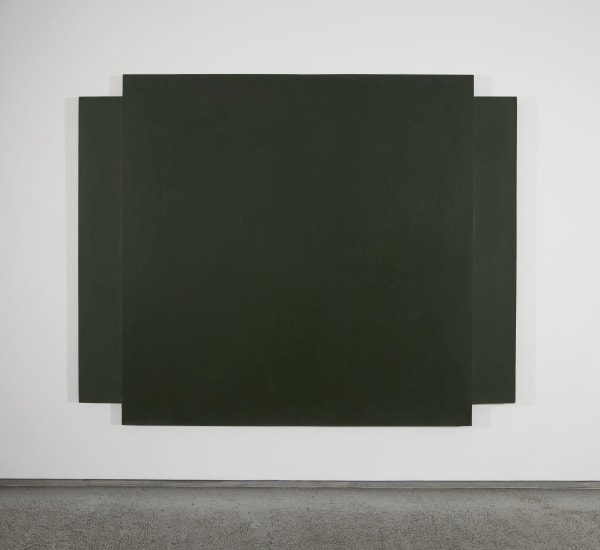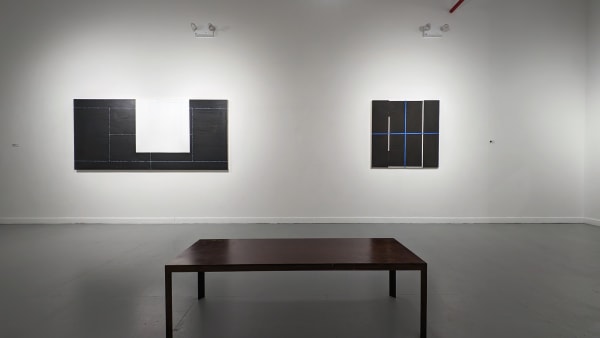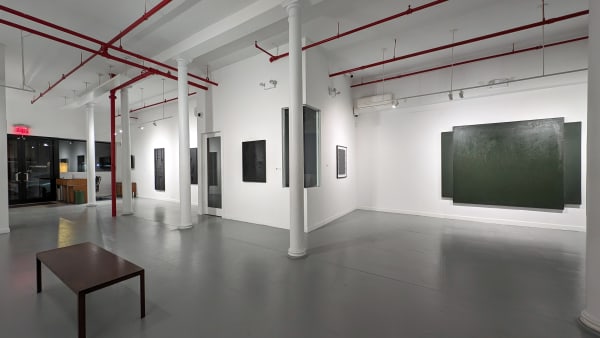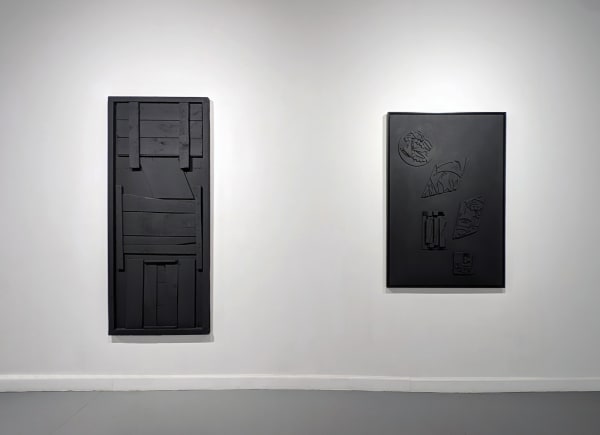Artists on the Bowery Part 5: Jake Berthot, David Diao, Harmony Hammond, Louise Nevelson, Harvey Quaytman, Carrie Yamaoka
WESTWOOD GALLERY NYC presents Artists on the Bowery Part 5, a group exhibition of recent and historic paintings, works on paper, and sculpture by artists Jake Berthot, David Diao, Harmony Hammond, Louise Nevelson, Harvey Quaytman, and Carrie Yamaoka, curated by James Cavello. WESTWOOD GALLERY NYC is pleased to collaborate on the exhibition with the Betty Cuningham Gallery, Greene Naftali Gallery, Alexander Gray Associates, Pace Gallery, Van Doren Waxter, and Ulterior Gallery.
The Artists on the Bowery exhibition series at WESTWOOD GALLERY NYC focuses on Contemporary artists who have lived and worked in the Bowery Arts District between 1960s-present. A cultural touchstone of New York City, the Bowery has been home to hundreds of artists, many of whom were the impetus of the most important art historical movements of the 20th and 21st centuries, including Minimalism, Conceptual Art, Abstract Expressionism, Feminist art, Hard-edge Painting, and many others. This year’s Artists on the Bowery survey focused on six artists who (1) brought a unique originality to the confining limitations of Minimalist and Abstract Expressionist art, and (2) created work that approaches the absence of color, by either directly using black pigments or creating illusory surfaces that feign color. The exhibition was on view March 14–May 11, 2024.
-
 David Diao, Open/Surrender and Mourn, big/bw, 2010
David Diao, Open/Surrender and Mourn, big/bw, 2010 -
 Louise Nevelson, Untitled, 1976-78
Louise Nevelson, Untitled, 1976-78 -
 Jake Berthot, Egypt, 1972
Jake Berthot, Egypt, 1972 -
 Harmony Hammond, Aperture #6, 2013
Harmony Hammond, Aperture #6, 2013
-
 Artists on the Bowery Part 5: Jake Berthot, David Diao, Harmony Hammond, Louise Nevelson, Harvey Quaytman, Carrie Yamaoka | Installation View
Artists on the Bowery Part 5: Jake Berthot, David Diao, Harmony Hammond, Louise Nevelson, Harvey Quaytman, Carrie Yamaoka | Installation View -
 Artists on the Bowery Part 5: Jake Berthot, David Diao, Harmony Hammond, Louise Nevelson, Harvey Quaytman, Carrie Yamaoka | Installation View
Artists on the Bowery Part 5: Jake Berthot, David Diao, Harmony Hammond, Louise Nevelson, Harvey Quaytman, Carrie Yamaoka | Installation View -
 Artists on the Bowery Part 5: Jake Berthot, David Diao, Harmony Hammond, Louise Nevelson, Harvey Quaytman, Carrie Yamaoka | Installation View
Artists on the Bowery Part 5: Jake Berthot, David Diao, Harmony Hammond, Louise Nevelson, Harvey Quaytman, Carrie Yamaoka | Installation View -
 Artists on the Bowery Part 5: Jake Berthot, David Diao, Harmony Hammond, Louise Nevelson, Harvey Quaytman, Carrie Yamaoka | Installation View
Artists on the Bowery Part 5: Jake Berthot, David Diao, Harmony Hammond, Louise Nevelson, Harvey Quaytman, Carrie Yamaoka | Installation View -
 Artists on the Bowery Part 5: Jake Berthot, David Diao, Harmony Hammond, Louise Nevelson, Harvey Quaytman, Carrie Yamaoka | Installation View
Artists on the Bowery Part 5: Jake Berthot, David Diao, Harmony Hammond, Louise Nevelson, Harvey Quaytman, Carrie Yamaoka | Installation View -
 Artists on the Bowery Part 5: Jake Berthot, David Diao, Harmony Hammond, Louise Nevelson, Harvey Quaytman, Carrie Yamaoka | Installation View
Artists on the Bowery Part 5: Jake Berthot, David Diao, Harmony Hammond, Louise Nevelson, Harvey Quaytman, Carrie Yamaoka | Installation View -
 Artists on the Bowery Part 5: Jake Berthot, David Diao, Harmony Hammond, Louise Nevelson, Harvey Quaytman, Carrie Yamaoka | Installation View
Artists on the Bowery Part 5: Jake Berthot, David Diao, Harmony Hammond, Louise Nevelson, Harvey Quaytman, Carrie Yamaoka | Installation View -
 Artists on the Bowery Part 5: Jake Berthot, David Diao, Harmony Hammond, Louise Nevelson, Harvey Quaytman, Carrie Yamaoka | Installation View
Artists on the Bowery Part 5: Jake Berthot, David Diao, Harmony Hammond, Louise Nevelson, Harvey Quaytman, Carrie Yamaoka | Installation View -
 Artists on the Bowery Part 5: Jake Berthot, David Diao, Harmony Hammond, Louise Nevelson, Harvey Quaytman, Carrie Yamaoka | Installation View
Artists on the Bowery Part 5: Jake Berthot, David Diao, Harmony Hammond, Louise Nevelson, Harvey Quaytman, Carrie Yamaoka | Installation View -
 Artists on the Bowery Part 5: Jake Berthot, David Diao, Harmony Hammond, Louise Nevelson, Harvey Quaytman, Carrie Yamaoka | Installation View
Artists on the Bowery Part 5: Jake Berthot, David Diao, Harmony Hammond, Louise Nevelson, Harvey Quaytman, Carrie Yamaoka | Installation View -
 Artists on the Bowery Part 5: Jake Berthot, David Diao, Harmony Hammond, Louise Nevelson, Harvey Quaytman, Carrie Yamaoka | Installation View
Artists on the Bowery Part 5: Jake Berthot, David Diao, Harmony Hammond, Louise Nevelson, Harvey Quaytman, Carrie Yamaoka | Installation View -
 Artists on the Bowery Part 5: Jake Berthot, David Diao, Harmony Hammond, Louise Nevelson, Harvey Quaytman, Carrie Yamaoka | Installation View
Artists on the Bowery Part 5: Jake Berthot, David Diao, Harmony Hammond, Louise Nevelson, Harvey Quaytman, Carrie Yamaoka | Installation View -
 Artists on the Bowery Part 5: Jake Berthot, David Diao, Harmony Hammond, Louise Nevelson, Harvey Quaytman, Carrie Yamaoka | Installation View
Artists on the Bowery Part 5: Jake Berthot, David Diao, Harmony Hammond, Louise Nevelson, Harvey Quaytman, Carrie Yamaoka | Installation View -
 Artists on the Bowery Part 5: Jake Berthot, David Diao, Harmony Hammond, Louise Nevelson, Harvey Quaytman, Carrie Yamaoka | Installation View
Artists on the Bowery Part 5: Jake Berthot, David Diao, Harmony Hammond, Louise Nevelson, Harvey Quaytman, Carrie Yamaoka | Installation View -
 Artists on the Bowery Part 5: Jake Berthot, David Diao, Harmony Hammond, Louise Nevelson, Harvey Quaytman, Carrie Yamaoka | Installation View
Artists on the Bowery Part 5: Jake Berthot, David Diao, Harmony Hammond, Louise Nevelson, Harvey Quaytman, Carrie Yamaoka | Installation View -
 Artists on the Bowery Part 5: Jake Berthot, David Diao, Harmony Hammond, Louise Nevelson, Harvey Quaytman, Carrie Yamaoka | Installation View
Artists on the Bowery Part 5: Jake Berthot, David Diao, Harmony Hammond, Louise Nevelson, Harvey Quaytman, Carrie Yamaoka | Installation View -
 Artists on the Bowery Part 5: Jake Berthot, David Diao, Harmony Hammond, Louise Nevelson, Harvey Quaytman, Carrie Yamaoka | Installation View
Artists on the Bowery Part 5: Jake Berthot, David Diao, Harmony Hammond, Louise Nevelson, Harvey Quaytman, Carrie Yamaoka | Installation View -
 Artists on the Bowery Part 5: Jake Berthot, David Diao, Harmony Hammond, Louise Nevelson, Harvey Quaytman, Carrie Yamaoka | Installation View
Artists on the Bowery Part 5: Jake Berthot, David Diao, Harmony Hammond, Louise Nevelson, Harvey Quaytman, Carrie Yamaoka | Installation View -
 Artists on the Bowery Part 5: Jake Berthot, David Diao, Harmony Hammond, Louise Nevelson, Harvey Quaytman, Carrie Yamaoka | Installation View
Artists on the Bowery Part 5: Jake Berthot, David Diao, Harmony Hammond, Louise Nevelson, Harvey Quaytman, Carrie Yamaoka | Installation View
WESTWOOD GALLERY NYC presents Artists on the Bowery Part 5, a group exhibition of recent and historic paintings, works on paper, and sculpture by artists Jake Berthot, David Diao, Harmony Hammond, Louise Nevelson, Harvey Quaytman, and Carrie Yamaoka, curated by James Cavello. WESTWOOD GALLERY NYC is pleased to collaborate on the exhibition with the Betty Cuningham Gallery, Greene Naftali Gallery, Alexander Gray Associates, Pace Gallery, Van Doren Waxter, and Ulterior Gallery.
This is the fifth exhibition in a series at WESTWOOD GALLERY NYC focused on Contemporary artists who have lived and worked in the Bowery Arts District between 1960s-present. A cultural touchstone of New York City, the Bowery has been home to hundreds of artists, many of whom were the impetus of the most important art historical movements of the 20th and 21st centuries, including Minimalism, Conceptual Art, Abstract Expressionism, Feminist art, Hard-edge Painting, and many others.
This year’s Artists on the Bowery survey focuses on six artists who (1) brought a unique originality to the confining limitations of Minimalist and Abstract Expressionist art, and (2) created work that approaches the absence of color, by either directly using black pigments or creating illusory surfaces that feign color.
Jake Berthot (1939-2014) is an American self-taught abstract painter who began exhibiting in 1970 outside of the traditional tenets of Minimalism. Utilizing the structure of the grid, Berthot twists it to achieve multiple vanishing points, softening his canvas while retaining high emotion. His subdued surfaces evoke action painting and a shared affinity with Milton Resnick and Mark Rothko. In Egypt (1972), Berthot uses monochromes of dark gray and dark green as an infinite and illusory blackness, pointing towards the painter’s awareness of his mortality.
David Diao (b. 1943) is a Chinese American artist who left China under extreme circumstances during the Communist takeover. His childhood home in Chengdu was confiscated and made into the offices of the Sichuan Daily. He returned after 30 years to find the former structure was demolished. The only scale memory Diao has of the family home was a tennis court they had on their property. As a part of his series entitled Da Hen Li (大亨里) Cycle, Diao repeated the symbolic court in a selection of paintings. On view in the exhibition, Open: Surrender and Mourn (2010) is rendered in black and white, taking on greater context with the traditional Chinese white as a color for mourning. Reminiscent of Robert Motherwell’s Open No. 150: In Black and Cream (Rothko Elegy) (1970) in honor of Mark Rothko, Diao’s canvas takes on a similar poignance in honor of his father, who died suddenly on a Long Island tennis court in 1990.
Harmony Hammond (b. 1944) is an American artist who is a leading member in the development of the 1970s feminist art movement in New York as well as a co-founder of A.I.R., the first women’s cooperative art gallery in New York. Throughout her career, Hammond has been interested in material and process in her painting practice and in pushing traditional printmaking. In her paintings, she utilizes fabrics, grommets, and mixed media elements to disrupt the grid, many times focusing on the juxtaposition of that grid with the meditative aspects of repetitive gestures that heal and protect the surface. First taking these ideas to paper in 2011 with master printer Marina Ancona at 10 Grand Press, Hammond created a series of Grommetypes, built up layers of wet-onto-wet ink printed onto pre-grommeted handmade paper. On view in the exhibition are two unique works in near-monochrome black, one from her Aperture and one from her Rim series. Despite their sparse materials of ink, grommets, and paper, the monotypes expand on Hammond’s notions of the grid, burying the texture of the base layer behind accumulations of ink, like new skin.
Louise Nevelson (1899-1988) was a leading American sculptor widely recognized for her monochromatic structures composed of scavenged wooden fragments. Formed from her initial interests in shadow and space, Nevelson’s box-like sculptures are iconographic to the canon of post-war art and occupy a unique voice building upon Cubism, Constructivism, Abstract Expressionism, and Minimalism. Nevelson uniformly covered her sculptures in white, black, or gold paint, homogenizing the surface while allowing for the divergent interaction of textures in the found wooden objects. Black was her signature, a way to freeze shadow and form to reflect the totality of her objects. The exhibition features two sculptures, a key work from her 1966 series Northern Shores and a large-scale 1976-78 untitled wall-relief that singularly highlights planks of wood in a grid-like application. Because of her just-off Bowery studio on Mott Street, Nevelson’s work not only reflects her belief of ‘black as all color’ but mirrors a portrait of downtown New York City.
Harvey Quaytman (1937-2002) joined the art world in the 70s and 80s, when the focus was on Neo-Expressionism, Minimalism, Conceptualism, and the Pictures Generation. Known for his distinctive hard-edge canvases, Quaytman began a series of square paintings in the 80s concerned with both shape and color around the structural form of an equilateral cross. Removing its emblematic meaning, Quaytman’s cruciform paintings utilize a palette of white, black, blue, and crushed glass to divide the canvas into quadrants that reveal the similarities and nuances of color, texture, and composition.
Carrie Yamaoka (b. 1957) is a New York-based visual artist whose unique artworks exist in a liminal space between painting, drawing, photography, and sculpture. Since the mid-1990s, she has been interested in materiality and process as a means to create objects that allow the viewer to experience and interact with her work as a constantly changing environment. Her working methods deploy strategies for the material to respond to chemical changes in its surface. In recent works, Yamaoka folds and unfolds a vinyl sheet before applying it to a wood panel and pouring clear resin to bond with the surface. The resulting abstractions reject a minimalist perfection and instead reveal the dynamism between the object and the viewer looking at a distorted reflection of their reality. Talking about her work, Yamaoka says: “[The viewer] makes the picture. I’m only setting up the situation for them to constantly create a picture that is constantly changing that’s always fleeting, that they can never really hold on to.” The black vinyl accentuates the purity of her reflections, while simultaneously revealing their imperfections.
Berthot, Diao, Hammond, Nevelson, Quaytman, and Yamaoka are all artists who uniquely challenge the limitations of what and how art can be. Accentuating their ideas through the absence of color, these artists take the precision and purity of the grid and reflect back mortality, imperfection, and the nuances of our reality.
But perhaps, in a 1976 conversation in Dawns + Dusks: Taped Conversations with Diana MacKown, Louise Nevelson says it best:
“But when I fell in love with black, it contained all color. It wasn’t a negation of color. It was an acceptance. Because black encompasses all colors. Black is the most aristocratic color of all.…. You can be quiet and it contains the whole thing. There is no color that will give you the feeling of totality. Of peace. Of greatness. Of quietness. Of excitement. I have seen things that were transformed into black, that took on just greatness. I don’t know a lesser word.”
ABOUT THE BOWERY
Although the Bowery carries its more recent past as ‘skid row,’ it started in the 1600s as one of America’s first and oldest streets, named after the Dutch bouweries, or cattle and produce farms that lined its path. Paralleling Broadway to its west, the Bowery was a main thoroughfare of New York, soon to be host to theaters, nickelodeons, dance halls, beer gardens, and taverns in the 19th century. But as Broadway flourished, the Bowery decayed, falling into threats of danger by gang violence in the shadow of the Third Avenue Elevated rail from 1878-1955. It soon became a no-man’s land home to the colloquially named “Bowery Bums.”
In the danger and the wreckage, artists began to move into the old spaces, transforming old flop houses, factory lofts, schools, banks, wholesale lighting, and kitchen supply stores into vast and soaring studio spaces. From the 1940s to 1970s, it became a live/work home for Mark Rothko, Clyfford Still, Al Loving, Fernand Léger, Jean Dubuffet, Willem de Kooning, Franz Kline, Arman, Dorothea Rockburne, Elizabeth Murray, Jack Tworkov, Robert Indiana, Eva Hesse, Will Insley, Robert Ryman, Lynda Benglis, Cy Twombly, Charles Hinman, James Rosenquist, John Giorno, Sol Lewitt, Adrian Piper, Roy Lichtenstein, Janet Fish, Joe Overstreet, Inger Johanne Grytting, Tom Wesselmann, Roger Welch, Alan Steele, and numerous other artists alongside the six artists featured in the gallery exhibition. These pioneer artists are responsible for creating a legacy of cultural assets in New York City.
Westwood Gallery NYC is proud to call the Bowery its home and is devoted to the recontextualization of the Bowery Arts District as a major cultural hub of New York City and the US.






























